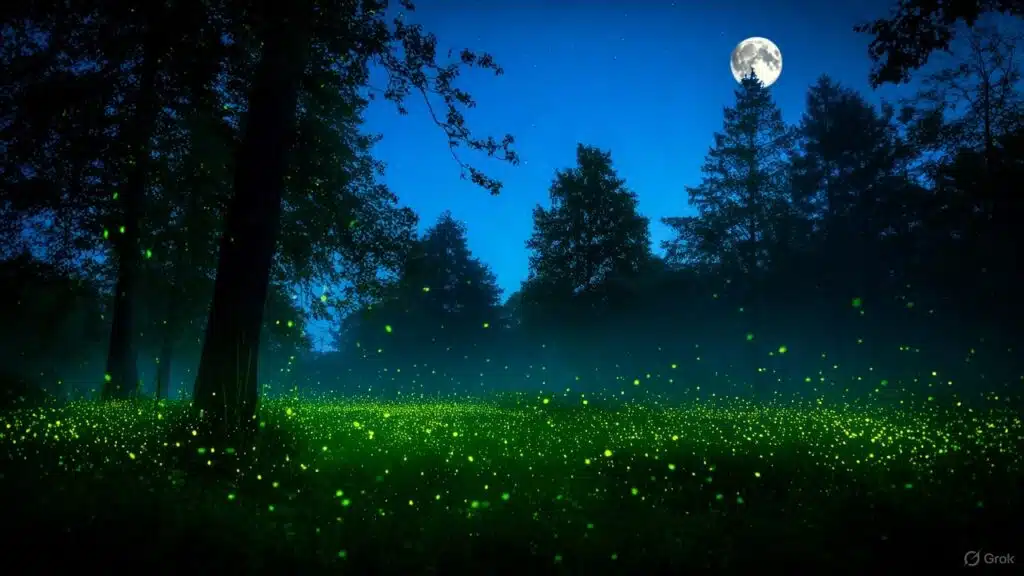On a warm summer evening, when the sky turns dark and the air feels magical, tiny sparkling lights often appear in the grass, trees, and bushes. These lights look like stars dancing on the ground. Who makes them? Fireflies! Also called lightning bugs, fireflies are insects with a very special power – they can glow in the dark. But why do they glow? Let’s explore the science and wonder behind these little glowing creatures.
What Are Fireflies?
Fireflies are insects, just like beetles and butterflies. They live in warm, damp places such as gardens, forests, and near rivers or ponds. Fireflies are most active at night because their glowing lights are easy to see in the dark.
Even though we call them “flies,” fireflies are actually beetles. Their glowing bellies make them one of the most fascinating insects on Earth.
The Science Behind the Glow
So, how do fireflies create light? The glow comes from a process called bioluminescence.
Inside their lower abdomen (the belly part), fireflies have special chemicals:
- Luciferin – a light-producing chemical
- Luciferase – an enzyme that helps the chemical reaction
- Oxygen – from the air they breathe
- ATP (energy molecule) – fuels the process
When all these mix together, a chemical reaction happens, and the result is light without heat. This is called “cold light,” which is different from a bulb or fire that produces both heat and light.
So, a firefly’s glow is like a tiny natural lantern powered by chemistry!

Why Do Fireflies Glow?
Now comes the big mystery – why do these insects glow in the first place? Scientists have found some exciting reasons:
- To Attract Mates – Each species of firefly has its own glowing pattern. Males flash in a certain rhythm, and females respond with their own flashes. It’s like sending love signals in the dark!
- To Scare Predators – Fireflies taste bitter and can be poisonous to some animals. Their glow acts as a warning: “Don’t eat me!”
- To Communicate – Fireflies use their glow as a secret language to talk to each other.
- To Hunt (in some species) – Certain fireflies use light to trick and catch other insects.
So, their glow is not just for beauty – it’s survival magic!
Firefly Communication – Light as a Language
Imagine if you could speak by blinking a flashlight! That’s exactly what fireflies do. Each species has its own flash pattern. Some blink quickly, others slowly, and some even make little “flash dances” in the sky.
Scientists call this morse code of light. With just a blink, fireflies can say:
- “I’m here!”
- “Do you want to be friends?”
- “Stay away, I’m dangerous!”
This glowing language is one of nature’s coolest secrets.
The Magic of Firefly Nights
In many parts of the world, fireflies put on glowing shows during summer. Entire fields and trees light up with twinkling bugs, almost like natural fairy lights. In some forests, especially in Asia and America, thousands of fireflies flash in sync – meaning they all blink at the same time!
This phenomenon, called synchronous flashing, makes the forest look like it’s alive with magic. People travel from far away just to see these breathtaking firefly festivals.

Fireflies and the Environment
Fireflies are more than just pretty lights. They are important for nature:
- They help control insect populations by eating pests.
- They are food for birds, frogs, and other animals (though some avoid them because of their bitter taste).
- Their glowing signals help scientists study ecosystems.
But sadly, fireflies are disappearing in many places because of pollution, pesticides, and too much artificial light from street lamps and buildings.
Fun Facts About Fireflies
- There are over 2,000 species of fireflies in the world.
- Not all fireflies glow – some species have lost their ability to shine.
- Firefly light is the most efficient light in the world, with almost no energy wasted as heat.
- Firefly larvae (baby fireflies) also glow! They are sometimes called “glow worms.”
- Some fireflies flash differently in different parts of the world, almost like having regional accents.
Can Humans Use Firefly Light?
Scientists are studying firefly light to create new technologies. For example:
- Medical Research – Firefly chemicals help scientists detect diseases.
- Eco-Friendly Lights – Studying fireflies might inspire new energy-efficient bulbs.
- Space Exploration – Cold light like fireflies produce could one day help astronauts use less power.
So, these tiny glowing bugs may even help us in the future!
Why Kids Should Care About Fireflies
Fireflies remind us that nature is full of wonder. Their tiny bodies hold secrets of science, beauty, and survival. By protecting fireflies, kids also help protect forests, rivers, and healthy environments.
If we reduce pollution, save natural habitats, and turn off unnecessary lights, fireflies will continue to glow for generations to come.
Conclusion
Fireflies are like little lanterns of the night. Their glow is not just for decoration – it’s a powerful tool for survival, communication, and love. From chemical magic inside their bellies to dazzling light shows in forests, fireflies show us how nature is both mysterious and magical.
Next time you see a glowing firefly on a summer night, remember: you are looking at one of the Earth’s tiniest superheroes, carrying the secret of light in its body. Fireflies truly are the shining stars of the insect world!

